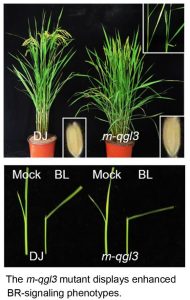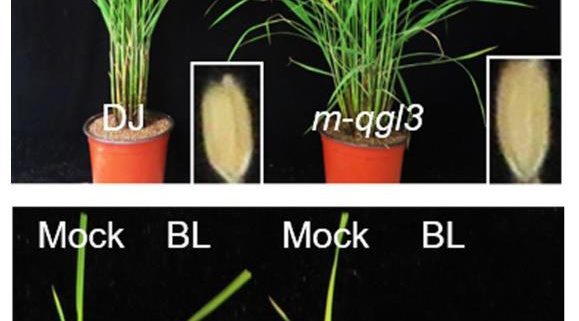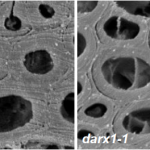Making longer rice grains, the brassinosteroid way
Gao et al. identified a key protein phosphatase regulator of brassinosteroid signalling that modulates grain length and plant architecture. https://doi.org/10.1105/tpc.18.00836
By Ji Huang, State Key Laboratory of Crop Genetics and Germplasm Enhancement, College of Agriculture, Nanjing Agricultural University, Nanjing 210095, China
Background: Brassinosteroids (BRs) are important plant hormones that play essential roles in plant growth and development. BRs affect many agronomic traits related to yield, including plant height, leaf angle, and grain size. The BR-insensitive mutants showed decreased lamina joint inclination, fewer tillers, and shorter grains. We previously cloned qGL3, a major quantitative trait locus regulating grain length in rice. N411, a variety with extra-large grains, has a rare qGL3 allele, qgl3, that produces its long-grain phenotype. 9311 is a high-quality elite rice variety with relatively smaller grains. Field trials showed that rice plants carrying the qgl3 allele had significantly increased grain yield due to its effect on grain length, filling, and weight. The qGL3 protein is a putative protein phosphatase and in N411 qGL3 has two amino acid changes compared with qGL39311. Although qGL3 plays a critical role in modulating grain length and yield, the precise functions of qGL3 remain largely unknown.
Question: We wanted to know how qGL3 regulates grain length.
 Findings: To examine the precise functions of qGL3, we first characterized the qGL3 knock-out mutant m-qgl3, which exhibited typical enhanced BR signaling phenotypes. The m-qgl3 phenotypes included increased lamina joint bending, more tillers, and increased grain length compared with the wild-type plants. We found that qGL3 from 9311 positively regulates the protein level of OsGSK3, a homologue of the Arabidopsis BR negative regulator BIN2. qGL39311 dephosphorylates and stabilizes OsGSK3, but qGL3N411 lacks this activity. OsGSK3 also suppresses BR signaling. Interestingly, qGL3 negatively regulates BR signaling, but its Arabidopsis homologue positively regulates BR signaling.
Findings: To examine the precise functions of qGL3, we first characterized the qGL3 knock-out mutant m-qgl3, which exhibited typical enhanced BR signaling phenotypes. The m-qgl3 phenotypes included increased lamina joint bending, more tillers, and increased grain length compared with the wild-type plants. We found that qGL3 from 9311 positively regulates the protein level of OsGSK3, a homologue of the Arabidopsis BR negative regulator BIN2. qGL39311 dephosphorylates and stabilizes OsGSK3, but qGL3N411 lacks this activity. OsGSK3 also suppresses BR signaling. Interestingly, qGL3 negatively regulates BR signaling, but its Arabidopsis homologue positively regulates BR signaling.
Next steps: We aim to elucidate the qGL3-involved regulatory network for BR signaling and explore its genetic manipulations to enhance rice grain yield in the future.
Xiuying Gao, Jiaqi Zhang, Xiaojun Zhang, Jun Zhou, Zhisheng Jiang, Peng Huang, Zhengbin Tang, Yongmei Bao, Jinping Cheng, Haijuan Tang, Wenhua Zhang, Hongsheng Zhang, and Ji Huang (2019). Rice qGL3/OsPPKL1 Functions with the GSK3/SHAGGY-Like Kinase OsGSK3 to Modulate Brassinosteroid Signaling https://doi.org/10.1105/tpc.18.00836



